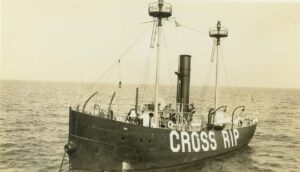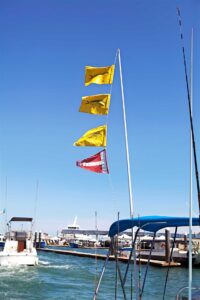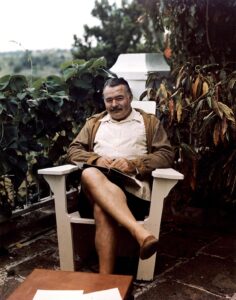The Florida Keys, a coral rock archipelago and accompanying barrier reef, stretch 200 nautical miles from Key Biscayne to the Dry Tortugas. The first European to see Biscayne Bay and sail through the Keys was probably Juan Ponce de Leon, during his voyage of discovery in 1513. He named them Los Martires, or the Martyrs, because from a distance the islands looked like suffering men to him. The name we use for the archipelago today is derived from a Spanish corruption, cayo, of the Taino Indian word for small island.
One of these cayos, 68 nautical miles east of the Dry Tortugas, was named Cayo Hueso, or Bone Island, perhaps because the area’s indigenous tribes used it as a graveyard. Today, it is what we know as Key West.
Key West has a famously colorful history, replete with eccentric characters and narrative twists and turns that a modern-day scriptwriter would have a hard time inventing. My favorite period runs from the 1830s to the turn of the 20th century, when Key West was the wealthiest city in the United States per capita. It was the era of the wrecker.
Wrecking was the practice of recovering valuables from ships that foundered close to shore. Wrecked Spanish galleons began littering the Florida Keys with gold and silver as early as the 1540s. The Keys were at the choke point for shipping from the southern United States, Mexico and the western Caribbean to the Atlantic Ocean via the Straits of Florida. Not only did the swift Gulf Stream current make navigation difficult, the waters between the Dry Tortugas and Key West are full of shoals and a dangerous coral reef. It was the perfect confluence of geography for wreckers.
Wrecking became a cottage industry in the early 1800s. Bahamian descendants of colonial Tories salvaged treasure in the Keys and auctioned it off in Nassau, greatly increasing the Bahamas’ wealth. Commercial New England fishermen spent winters off the Keys supplying fish to Havana wholesalers. Sensing a use for their boats more lucrative than fishing, the New Englanders began cutting into the business of the Bahamian salvagers. Conflicts between the two groups soon arose. In the 1820s, the U.S. Congress passed a law requiring any wrecks taken in U.S. waters to be valued solely by a U.S. court. Subsequently, Key West became the primary hub for selling the salvaged cargo — and many of the Bahamian wreckers moved permanently to Key West.
Wrecking vessels would normally anchor at night in protected anchorages along the Keys, then sail out in the morning to see if any ships had wrecked during the night. As a result, a ship that had run aground overnight might attract a dozen wreckers by the afternoon of the next day. The first wrecking captain to reach a stranded ship became the wreck master, determining how many wreckers he needed to salvage the ship and directing the operation. Wreckers had an obligation to save the passengers and crew of wrecked ships, and to salvage not only cargo but, if possible, the ship, as well. What had been salvaged was taken to Key West, where everything was appraised and often auctioned.
Wrecking became a big business — in those days, ships ran aground in the Keys on average once a week. Shipbuilding and repair yards and chandleries flourished in Key West. Warehouses for storing the treasure went up close to the wharves. Auction houses were constructed to handle the constant flow of goods — one prominent auctioneer is known to have made $10,000 in fees in one year, the equivalent of more than $300,000 today.
Eventually, lighthouses were built on the reef as navigational aids. The introduction of steamships, more maneuverable than ships under sail, also dramatically reduced the flow of wrecked vessels, and, consequently, the livelihoods of the wreckers. In 1921, a federal court issued its last wrecking license in Key West.
Today, cruising Key West in search of its rich wrecking history is best done by finding a secure berth for your yacht and then exploring the island on foot, bicycle or moped. Visit the Bight, a historic waterfront area filled with specialty shops, restaurants and bars that overflow with local musical talent. Take an island tour with the Old Town Trolley or the Conch Tour Train, and the history of Key West will come to life before your eyes.
Literary History By Bar
Literary giants to make the island their home for months or years at a time, and many of them have used the bars fanning off Duval Street as their muse. Ernest Hemingway and Sloppy Joe’s are forever entwined in local lore — but it’s not quite that simple. The current Captain Tony’s Saloon and Sloppy Joe’s Bar both claim to be the original Sloppy Joe’s, and the rights to the name are now the subject of a lawsuit.
As a recent article in South Florida’s Sun-Sentinel noted: “Sort through all the stories and this much is true: The original Sloppy Joe’s was in Havana, and no longer exists. From 1933 to 1937, “Sloppy Joe” Russell ran a bar out of a former city morgue where Captain Tony’s now is located…. Some believe the saloon at what is now Captain Tony’s was the inspiration for a bar Hemingway called “Freddy’s” in his Key West tome “To Have and Have Not”…. As the story goes, Russell abruptly moved half a block to the current Sloppy Joe’s location in 1937, upset that his landlord had raised the rent $6 a month. His patrons helped him move out — at midnight.”
It appears that the lawyers will have to duke it out to settle this dispute. Tennessee Williams also called Key West home. He first visited in 1941 to write plays and swim. Success soon followed with “The Glass Menagerie” and “A Streetcar Named Desire,” and Williams returned to call Key West home for 34 years. You can visit the Tennessee Williams Museum (513 Truman Avenue) and pass by his former residence at 1124 Duncan Street (currently a private home, it is not open to the public).
Other great literary figures who have lived in Key West include Tom McGuane, John Hersey, Shel Silverstein, Tom Corcoran and Judy Blume. To read about their Key West exploits, visit Books and Books at the Studios of Key West (533 Eaton St.), or attend the popular Key West Literary Seminar held in January.
WHERE TO DOCK
- Conch Harbor Marina accommodates vessels up to 200 feet and offers Valvtect fuel; the marina is in the center of activity along the wharf.
- Key West Bight Marina located in the bight area and owned by the city, the marina offers 33 deep-water slips for vessels up to 140 feet.
- Stock Island Marina Village is located next to Cow Key and offers complimentary shuttle service into Old Town Key West; it has 220 slips and state-of-the-art floating docks — and it’s pet-friendly, too! (305-294-2288, stockislandmarina.com)
WHERE TO VISIT
- Audubon House and Tropical Gardens 205 Whitehead St, 305-294-2116
- Customs House 281 Front St, 305-295-6616
- Key West Lighthouse 938 Whitehead St, 305-294-0012
- The Key West Shipwreck Museum 1 Whitehead St, 305-292-8990
- Mel Fisher Maritime Heritage Museum 200 Greene St, 305-294-2633
- Oldest House & Garden Museum 322 Duval St, 305-294-9501
Capt. Jeff Werner has been in the yachting industry for over 25 years. In addition to working as a captain on private and charter yachts, both sail and power, he is a certified instructor for the USCG, US Sailing, RYA and the MCA. He is also the Diesel Doctor, helping to keep your yacht’s fuel in optimal condition for peak performance. For more information, call 239-246-6810, or visit MyDieselDoctor.com. All Marinalife members receive a 10% discount on purchases of equipment, products and supplies from Diesel Doctor.





